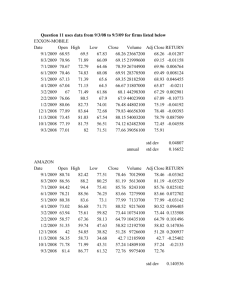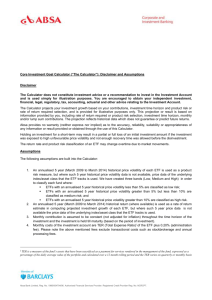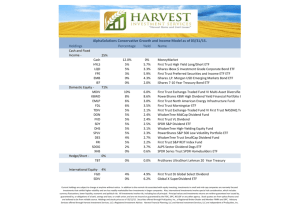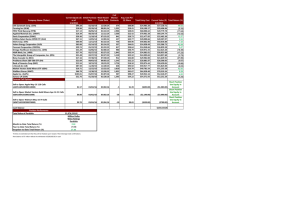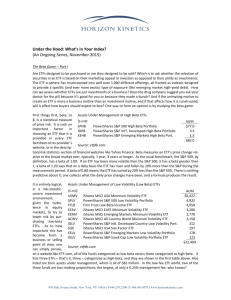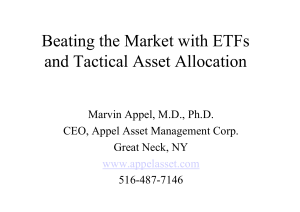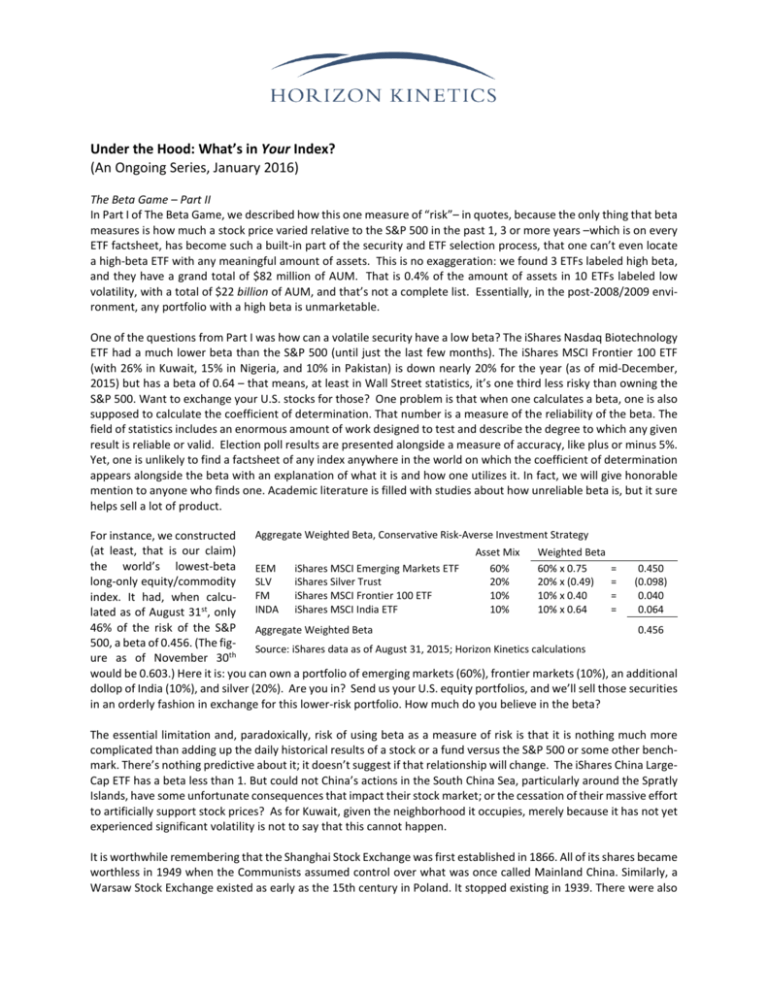
Under the Hood: What’s in Your Index?
(An Ongoing Series, January 2016)
The Beta Game – Part II
In Part I of The Beta Game, we described how this one measure of “risk”– in quotes, because the only thing that beta
measures is how much a stock price varied relative to the S&P 500 in the past 1, 3 or more years –which is on every
ETF factsheet, has become such a built-in part of the security and ETF selection process, that one can’t even locate
a high-beta ETF with any meaningful amount of assets. This is no exaggeration: we found 3 ETFs labeled high beta,
and they have a grand total of $82 million of AUM. That is 0.4% of the amount of assets in 10 ETFs labeled low
volatility, with a total of $22 billion of AUM, and that’s not a complete list. Essentially, in the post-2008/2009 environment, any portfolio with a high beta is unmarketable.
One of the questions from Part I was how can a volatile security have a low beta? The iShares Nasdaq Biotechnology
ETF had a much lower beta than the S&P 500 (until just the last few months). The iShares MSCI Frontier 100 ETF
(with 26% in Kuwait, 15% in Nigeria, and 10% in Pakistan) is down nearly 20% for the year (as of mid-December,
2015) but has a beta of 0.64 – that means, at least in Wall Street statistics, it’s one third less risky than owning the
S&P 500. Want to exchange your U.S. stocks for those? One problem is that when one calculates a beta, one is also
supposed to calculate the coefficient of determination. That number is a measure of the reliability of the beta. The
field of statistics includes an enormous amount of work designed to test and describe the degree to which any given
result is reliable or valid. Election poll results are presented alongside a measure of accuracy, like plus or minus 5%.
Yet, one is unlikely to find a factsheet of any index anywhere in the world on which the coefficient of determination
appears alongside the beta with an explanation of what it is and how one utilizes it. In fact, we will give honorable
mention to anyone who finds one. Academic literature is filled with studies about how unreliable beta is, but it sure
helps sell a lot of product.
Aggregate Weighted Beta, Conservative Risk-Averse Investment Strategy
For instance, we constructed
(at least, that is our claim)
Asset Mix
Weighted Beta
the world’s lowest-beta
EEM
iShares MSCI Emerging Markets ETF
60%
60% x 0.75
=
0.450
SLV
iShares Silver Trust
20%
20% x (0.49) =
(0.098)
long-only equity/commodity
FM
iShares MSCI Frontier 100 ETF
10%
10% x 0.40
=
0.040
index. It had, when calcuINDA iShares MSCI India ETF
10%
10% x 0.64
=
0.064
lated as of August 31st, only
46% of the risk of the S&P
Aggregate Weighted Beta
0.456
500, a beta of 0.456. (The figSource: iShares data as of August 31, 2015; Horizon Kinetics calculations
ure as of November 30th
would be 0.603.) Here it is: you can own a portfolio of emerging markets (60%), frontier markets (10%), an additional
dollop of India (10%), and silver (20%). Are you in? Send us your U.S. equity portfolios, and we’ll sell those securities
in an orderly fashion in exchange for this lower-risk portfolio. How much do you believe in the beta?
The essential limitation and, paradoxically, risk of using beta as a measure of risk is that it is nothing much more
complicated than adding up the daily historical results of a stock or a fund versus the S&P 500 or some other benchmark. There’s nothing predictive about it; it doesn’t suggest if that relationship will change. The iShares China LargeCap ETF has a beta less than 1. But could not China’s actions in the South China Sea, particularly around the Spratly
Islands, have some unfortunate consequences that impact their stock market; or the cessation of their massive effort
to artificially support stock prices? As for Kuwait, given the neighborhood it occupies, merely because it has not yet
experienced significant volatility is not to say that this cannot happen.
It is worthwhile remembering that the Shanghai Stock Exchange was first established in 1866. All of its shares became
worthless in 1949 when the Communists assumed control over what was once called Mainland China. Similarly, a
Warsaw Stock Exchange existed as early as the 15th century in Poland. It stopped existing in 1939. There were also
exchanges in Krakow, Katowice, Lvov, Lodz, Poznan, and Wilno, and all disappeared. There was a Bucharest Stock
Exchange in Romania as early as 1839. It disappeared in 1949, with the Communist takeover.
A student of historical statistics in 1948 might have been tempted to conclude that the Bucharest exchange was
uncorrelated with the Shanghai exchange. This proved not to be the case, as both exchanges became worthless
almost at the same time. Surely there must be a better way to measure risk than historical statistics.
Another question from Part I was why an investor would even have an interest in a high-beta security? An awful lot
of college graduates today – and non-graduates and high school students – dream of creating a new phone app that
will strike a chord within the vast smart phone user base: a guitar tuner application, an app to locate a lost phone,
or to remotely program your television. No one tells them it’s a foolish idea – programmers like that are a new form
of rock star. What would be the corollary in the investment world? How about a strategy that selects the stocks in
an industry that has had the greatest declines, but only companies that have strong balance sheets and positive cash
flow, so that the selection is about low valuation, not low business or balance sheet quality? Like in the oil industry?
Like blue chip companies such as Chevron or Schlumberger, still enormously profitable after a precipitous drop in
their revenues, and which have weathered such environments many times before, and which would produce 50%
returns just to recover to their previous levels? It’s not our cup of tea, but it’s not a bad idea. And it would be a
portfolio diversifier. Can’t happen. Really, it can’t. Why? Because that index won’t back test well. Which is to say
that the standardized historical statistic, beta, will produce an unacceptable figure. The energy companies dropped
more sharply in price than the S&P 500, which means they all have a beta greater than 1.0. The ETF manufacturer
won’t even bother to try to make the ETF. How do we know? Because it was tried.
In the earlier years of the indexation era, there were a number of attempts to create ETFs based upon contrarian
investment approaches. A contrarian is one who invests by purchasing assets that have performed poorly; in other
words, one who invests in a manner adverse to the prevailing sentiment of the moment. Some of the most successful
and famous investors of all time have been contrarians. Such a list would include John Templeton and Sam Zell, as
well as Carl Icahn. The list of contrarians could well be much longer, if such a list were ever to be compiled.
Unfortunately—or perhaps fortunately, depending on one’s perspective—such investment strategies are rarely emulated in the world of indexation. The market long ago pronounced judgment upon the contrarian approach, and it
has been found to be wanting. A Russell Contrarian ETF (CNTR), was launched in 2011; it closed in 2012 due to lack
of interest. A similarly constructed Jets Contrarian Opportunities Index Fund, (JCO), closed in 2011. Russell tried
another contrarian ETF with the launch of the Russell Small-Cap Contrarian ETF (SCTR); this closed in 2012 as well.
Incidentally, ELEMENTS (a series of exchange-traded notes) fared no better with the aptly named Benjamin Graham
Value Series: the Benjamin Graham Total Market ETN (BVT); the Benjamin Graham Large Cap Value ETN (BVL); and
the Benjamin Graham Small Cap Value ETN (BSC). All these funds closed in 2011.
Russell also tried the Russell Growth At a Reasonable Price ETF (GRPC); this closed in 2012. The same lack of investor
interest occurred with the Russell Low P/E ETF (LWPE) and the Russell Small Cap Low-P/E ETF (SCLP). In fact, there
are no low-P/E ETFs as such, although there can be indexes that, coincidentally, develop a low P/E ratio at a given
point in time.
But the reality of the markets and security prices is ultimately expressed through the balance of supply and demand.
Just as the demand since 2008/2009 has been almost exclusively for large capitalization companies with liquid shares
that can be traded readily in multi-billion dollar ETFs, a subsidence of that demand (since valuations cannot expand
indefinitely, nor interest rates remain near zero indefinitely, nor corporate profit margins remain at record levels
indefinitely) will set into reverse the liquidity-driven price increases and price stability of the index-centric stocks.
We believe that demand will ultimately shift to securities that exhibit what will then be more pleasing statistics, such
as the contrarian or more idiosyncratic/less correlated securities. For those who already hold them, there will be
the additional benefit that they are not as liquid.
Disclosures:
Past performance is not indicative of future results. This information should not be used as a general guide to investing or as a source of any specific investment recommendations. This is not an offer to sell or a solicitation to
invest. Opinions and estimates offered constitute the judgment of Horizon Kinetics LLC (“Horizon Kinetics”) and are
subject to change without notice, as are statements of financial market trends, which are based on current market
conditions. Under no circumstances does the information contained within represent a recommendation to buy, hold
or sell any security, and it should not be assumed that the securities transactions or holdings discussed were or will
prove to be profitable.
Subsidiaries of Horizon Kinetics LLC manage separate accounts and pooled products that may hold certain of the
securities mentioned herein. For more information on Horizon Kinetics, you may visit our website at
www.horizonkinetics.com. No part of the research analysts’ compensation was, is, or will be, directly or indirectly,
related to the specific recommendations or views expressed by the research analysts in the research report.
All material presented is compiled from sources believed to be reliable, but no guarantee is given as to its accuracy.
No part of this material may be: a) copied, photocopied, or duplicated in any form, by any means; or b) redistributed
without Horizon Kinetics’ prior written consent.
©2016 Horizon Kinetics LLC ® All rights reserved.


